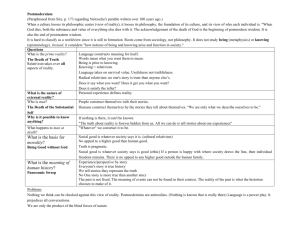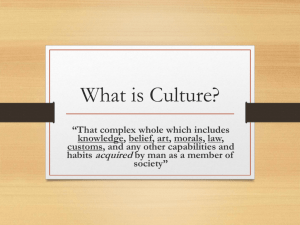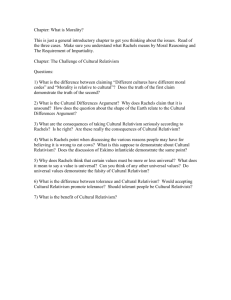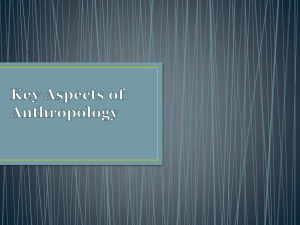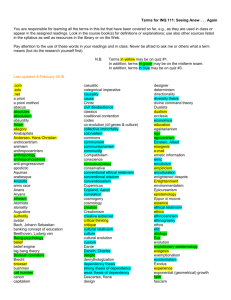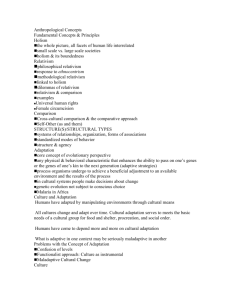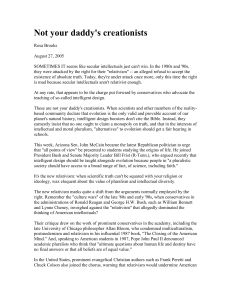PPT - Gmu
advertisement
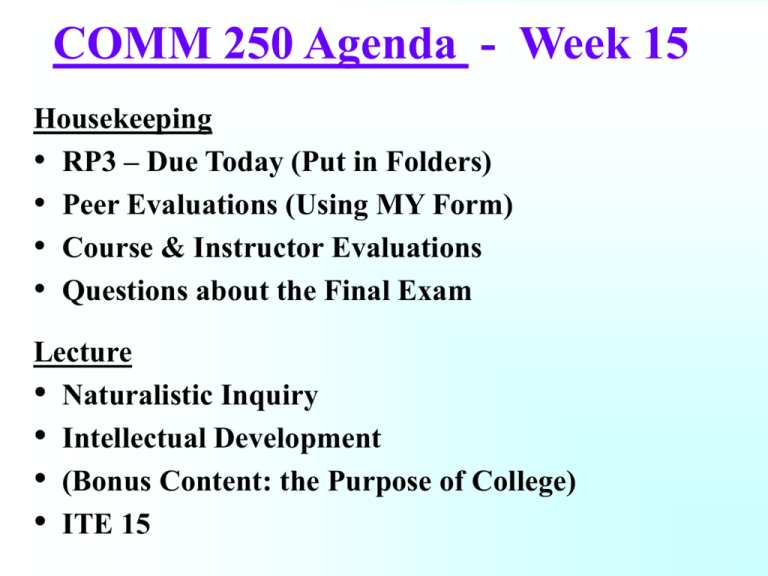
COMM 250 Agenda - Week 15 Housekeeping • RP3 – Due Today (Put in Folders) • Peer Evaluations (Using MY Form) • Course & Instructor Evaluations • Questions about the Final Exam Lecture • Naturalistic Inquiry • Intellectual Development • (Bonus Content: the Purpose of College) • ITE 15 Overall Peer Evaluation Rate Your Teammates • Do NOT Rate Yourself • Total Points = 10 x the # Teammates • You Can’t Give Everyone the Same Score • Use Whole Numbers; Make Sure They Add Up! This is a Secret Ballot • No Talking or Comparing Scores • Place Rating Sheets Face Down • Staple or Clip Them Together “You do not get an education in the classroom: you learn how to get an education, which in the long run you only acquire by yourself. In fact, the word "educate" comes from the Latin, educare which means "leading out" the student in a wider world of knowledge. It is by stimulating a zest for learning in general that teachers can perform their greatest service to those in their care, for a zest for learning is a zest for life.“ - The Importance of Teaching . Teaching is not presenting a lesson. The result of teaching is learning. If learning does not occur, there has been no teaching. - www.teachingtips.com Education is not the filling of a pail, but the lighting of a fire. (William Butler Yates) Exercise Each person spend 1 minute giving a VERY BRIEF SUMMARY of a situation that happened to them in a college course, where: 1. 2. 3. 4. You were still confused about an issue you had studied about in depth. A professor talked about something (theoretical) that you did not understand. You and/or the professor confused fact and interpretation. You disagreed with a professor’s argument that knowledge was “subjective” in some way. ----------------------------------------------------------------------------------------------------------------------------- ----------------------------------------------------------------------------------------------------- No Written Deliverable Intellectual Development William Perry – “Forms of intellectual and ethical development in the college years: A scheme” • A Qualitative Research Study • Interviewed Harvard Students in the 50s, 60s • Asked: “What stands out for you this year?” • Perry “Tracked” Individual Development • Created a 9-Position Model Using Induction Caveats Before Presenting ‘Perry’ • Everyone goes through these stages • College simply accelerates your movement • This is Finn’s version of Perry • Remember: Models are not “the truth;” • Models are approximations (in the world of ideas) of phenomenon (in the physical world) Preview of Perry A summary of where we’re headed There are several major stages of intellectual and ethical development: 1. Duality 2. Multiplicity 3. Relativism 4. Commitment The concept of ‘relativism’ is not to be feared: • It does not imply you can’t have beliefs & commitments • Relativism actually strengthens your beliefs & commitments • Yet people speak out “against it” all the time Relativism Several Types: • Aesthetic Relativism • Cognitive (Rational) Relativism • Moral Relativism Two Things in Common: • Any concept (e.g. art, knowledge, or values) is relative to the particular framework or world view being used (e.g. the individual, the culture, the era, the language). • No one point of view is uniquely privileged over all the others Basic Duality (Position 1, 2) • Our first view of knowledge is basic duality • Everything is either: • Right or wrong, Black or white, Good or bad • There are no shades of gray • All questions/problems are solvable • Authorities have the answers, or can get them • • (parents, teachers, experts, government) Knowledge: an objective body of facts Assignments: Designed to get the right answer Positions 1 & 2: Duality 1. Basic Duality 2. Multiplicity: Pre-Legitimate • As we get older, we notice that conflicting points of view exist • We assume not all authorities have “the truth” – some are mistaken • “I know there are other viewpoints AND, they are wrong.” • Assignments: Work through the issues, but come up with the (one) right answer Multiplicity (3, 4a) 3. Multiplicity: Subordinate 4a. Multiplicity: Correlate In “multiplicity subordinate,” there are 2 kinds of problems: those with known answers, and those where the answer is not yet known; Authority still has the answers • In “multiplicity correlate,” people accept epistemological uncertainty as a legitimate view • Knowledge: facts and principles that can be proven • Assignments: worry about whether this is a problem where the answer is not yet known Relativism (4b, 5, 6) 4b. Relativism Subordinate 5. Relativism: Correlate, Competing, Diffuse 6. Commitment: Foreseen In “relativism correlate:” • • • • there is more than one approach to a problem Math / science has answers; humanities, criticism do not) Knowledge: the way anyone choose to organize and interpret the information Assignments: the goal is to give the teachers what they want; many students learn to “shoot the bull” Relativism (4b, 5, 6) 4b. Relativism Subordinate 5. Relativism: Correlate, Competing, Diffuse 6. Commitment: Foreseen In “relativism diffuse:” • Full-blown acceptance of relativism • Knowledge by its nature, is seen as contextual • Assignments: some answers are better than others, depending on the context. The student’s job is to practice evaluating solutions. The test of a first-rate intelligence is the ability to hold two opposing ideas in mind at the same time and still retain the ability to function. - F. Scott Fitzgerald Commitment (7, 8, 9) 7. Initial Commitment 8. Orientation in Implications of Commitment 9. Developing Commitment In “Initial commitment:” • • • People realize they need to make choices about what (base of knowledge) to believe in To take action, to be effective, you must put a stake in the ground Not as w/ Duality, but having examined legitimate, competing alternative structures of knowledge Knowledge: constructed from one’s experience Commitment (7, 8, 9) 7. Initial Commitment 8. Orientation in Implications of Commitment 9. Developing Commitment In # 8 and # 9: • • #8: people see the trade-off between expansive possibilities and then narrowing after choosing #9: a continual expansion and updating of commitments Knowledge: relativists apply a complex test to novel ideas and issues Commitments are defensible and explainable in the context of a tested belief structure Final Thoughts on Intellectual Development • Perry is a simply one roadmap • It’s a structure to help explain the process – in • • college and beyond Think about Perry’s “Positions” when you don’t understand why a teacher did something (graded, critiqued, asked questions) The frustration, upset or confusion you feel may be traceable to being “pushed” to think at the next position (before you’re actually there) Naturalistic Inquiry The Basic Motives: Understanding and Explanation • What makes people tick? • Why do they believe what they believe? • How do their beliefs translate into some • behaviors and not others? What are the political consequences of their beliefs and actions? How do they affect others or the society as a whole? Assumptions of the Traditional “Scientific” Approach • Determinism • Objective Reality, Objective Science • Human behavior (DVs) is caused by (objective) social attributes & social forces (IVs). • The Task Determine which attributes or forces cause or shape specific social actions or behaviors. • Example Studies of the “Glass Ceiling” Missing from the “Scientific” Approach? • What does the “Glass Ceiling” mean, • • • experientially? What is the experience of women in large organizations? What is it like to be a woman in a large organization? What daily experiences add up to a sense of frustration or alienation? Imagine the benefits, to a researcher, of talking with, and getting to know, women who work in large organizations. Assumptions of Naturalistic Research • No assumption of determinism, objective • • • reality, objective research Human action is not guided by objective social forces. What people do depends upon what they perceive, upon their internalized understanding of their social world. “Human behavior is guided and patterned by the meanings that are created by communities and held by individuals." Four Assumptions Naturalistic Inquiry 1. What people say and do are the result of how they interpret and understand their social world. (It’s a Question of Ideology and Worldview.) 2. These ideologies are socially constructed. (We are socialized into a particular way of looking at ourselves and the social world.) Four Assumptions Naturalistic Inquiry 3. Different communities/societies impose different “senses” onto the same social reality. (Loggers versus environmentalists in the Pacific Northwest.) 4. Different Ideologies/Worldviews carry different political implications. (Researchers should pay attention to the political implications of their consultants’ worldviews.) The Goals of Naturalistic Inquiry • Understanding peoples’ social world and social actions from THEIR point of view. • What social experiences make up an individual’s or community's reality? • And how do people "make sense" of their reality? How does this "sense" guide their actions? • What are the social and political implications of their actions, ideologies, and worldviews? The Practice of Naturalistic Research Immersion in Social Settings • Being There. • Listening: Immersion in Language and Informants’ “Way of Speaking.” Immersion in Natural Settings • What practices and rituals make up the daily life of this social community? What ideologies about the world inform and animate these daily rituals? • Discovery through breaking the rules. Immersion in Language • The language informants use holds vital clues re: how they interpret their world. • The stories they tell… The metaphors they use… Naturalistic Research: A Journey of Discovery • The researcher journeys into new, unknown, • • or misunderstood social terrain. The researcher immerses her/himself in the ideologies and practices that distinguish this social terrain. The researcher tries to interpret and make sense of this social reality, from the subjects’ (consultants’) points of view.

